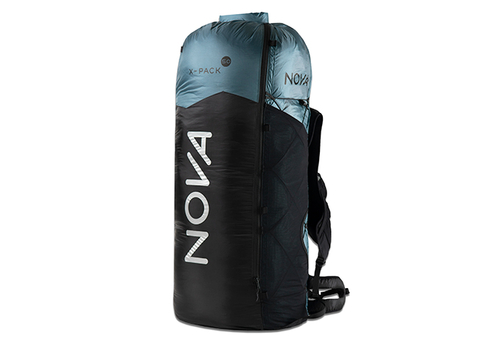The athlete version has already been intensively tested in extreme hike & fly races. For the standard version, we use more sturdy paraglider fabric as well as additional reinforcements in highly stressed areas. Thanks to the empirical evidence and the choice of materials, the X-PACK 50 is suitable for everyday use - but of course not as robust as backpacks made from much thicker fabrics. However, if a small hole or tear should occur during use, you can quickly and easily remedy the situation with adhesive patches.
The packing volume of the X-PACK 50 is approximately 50+10 litres. There is no table that tells you which equipment will fit in the X-PACK 50, as this depends on various factors (size and packing size of the glider and harness, packing method, accessories, etc.). As a general rule, however, the smaller and more compact your equipment is, the better it will fit in your backpack. The best thing to do is to try it out in-situ at your NOVA dealer or at a testival.
The load can either be distributed mainly to the hip belt or over the entire upper body. A long and flat-packed wing serves as a stiffening back element - like the frame in the carrying system of a trekking backpack. If you pack correctly, you can transfer the weight from your shoulders to your hips. With the help of the load control straps (= suspension straps between the shoulder straps and the rucksack) you can adjust how far back the rucksack hangs: uphill you set them a little longer, on the flat and downhill shorter. So there are various options to adjust the comfort of the X-PACK 50 to your requirements. Secret tip from hike & fly enthusiast Till Gottbrath: he folds his jacket flat and positions it between the back of the rucksack and the paraglider at lumbar level. This makes every hike & fly backpack fit even better.
The chest straps of the X-PACK 50 consist of elastic bungees whose length and position can be individually adjusted. The bungees are tied at four positions and attached to the other side by means of adjustable plastic hooks. Shortening can be done either by adjusting the hooks or, if the load is heavier, by tightening the bungees. The position of the chest straps can and should also be individually adjusted so that the straps rest comfortably and do not cause pressure sores.
No, it is not waterproof. The use of ultra-light materials rules this out. There is no ultra-light backpack that is permanently waterproof. Our tip: fold a large plastic bag, for example, so that it covers the inside of the back. It costs very little, protects your wing from sweat, and when it really rains, you pack all your equipment in the plastic bag and put it in your backpack. Our Compression Bags offer the perfect protection against moisture.



